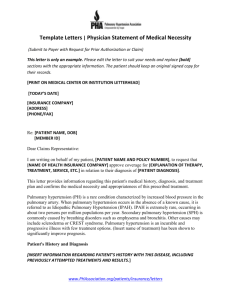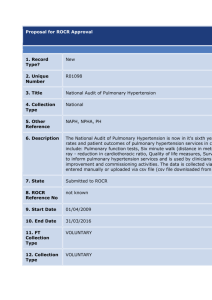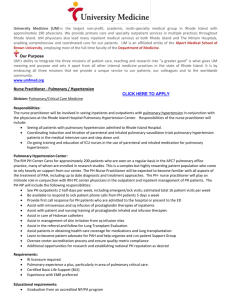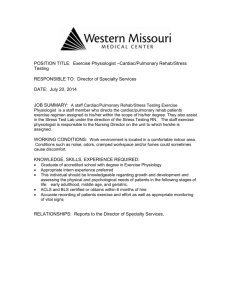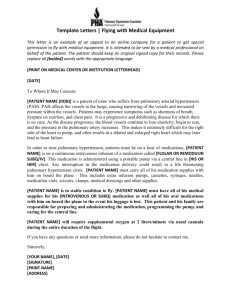Business Case
advertisement
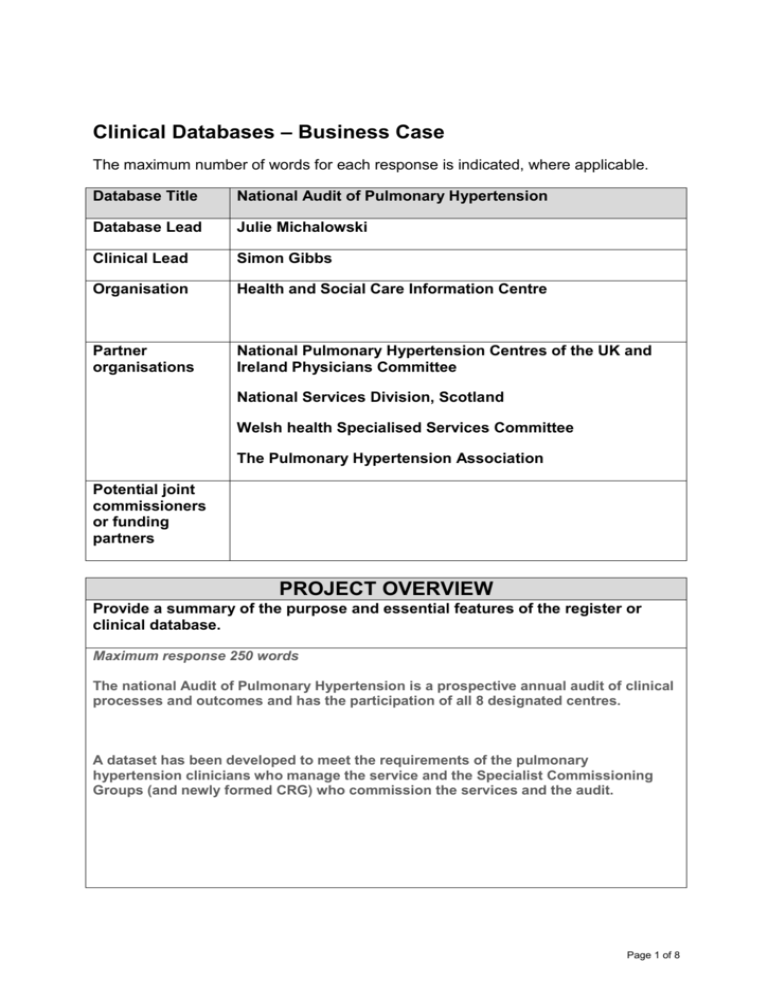
Clinical Databases – Business Case The maximum number of words for each response is indicated, where applicable. Database Title National Audit of Pulmonary Hypertension Database Lead Julie Michalowski Clinical Lead Simon Gibbs Organisation Health and Social Care Information Centre Partner organisations National Pulmonary Hypertension Centres of the UK and Ireland Physicians Committee National Services Division, Scotland Welsh health Specialised Services Committee The Pulmonary Hypertension Association Potential joint commissioners or funding partners PROJECT OVERVIEW Provide a summary of the purpose and essential features of the register or clinical database. Maximum response 250 words The national Audit of Pulmonary Hypertension is a prospective annual audit of clinical processes and outcomes and has the participation of all 8 designated centres. A dataset has been developed to meet the requirements of the pulmonary hypertension clinicians who manage the service and the Specialist Commissioning Groups (and newly formed CRG) who commission the services and the audit. Page 1 of 8 1.AIMS AND OUTCOMES 1.1 Clear description of project which demonstrates the purpose or aim(s) of data collection and clearly sets out what data will be collected; data should be simple, valid, reproducible and objective Maximum response 250 words The purpose of data collection is to be able to demonstrate national outcomes, a comparison between designated centres and to monitor the SCG Commissioning Policy. The data items collected can be found in appendix A 1.2 Please provide a description of the resources used to operate the system Maximum response 250 words Data entry within the designated centres is provided by a variety of staff – administrative, clinical, IT. An IT developer maintains the system along with helpdesk support to users. 1.3 Outline of the relevance of the register to Specialised Commissioning. Specify any relevant quality initiative or other governmental policy initiative the register may align with. Maximum response 250 words The audit allows the measurement of compliance against the national Pulmonary Hypertension prescribing guidelines and provides clinical indicators. 1.4 Scale; please identify the scope and size of dataset Maximum response 100 words All patients referred to pulmonary hypertension services nationally See Appendix A 1.5 Geographical coverage; please provide details of regional data collection Maximum response 100 words England, Scotland, Wales, Northern Ireland, Channel Islands, Isle of Man, Gibraltar & other British Overseas Territories Republic of Ireland have asked to join the audit and it is under consideration Page 2 of 8 2. DATA QUALITY, GOVERNANCE AND TRANSPARENCY 2.1 The database has a clear communication strategy which demonstrates how collected information will be accessible to both professionals and members of the public and at what level of detail. Maximum response 100 words Information is provided in the annual report published on the internet. We hope to provide published clinical indicators 2.2 The database demonstrates how data are disseminated to commissioners to aid commissioning of services. How frequently will data be fed back? Will the reports be fixed or will there be scope for flexibility in data provided? Maximum response 100 words SCG reports are produced on a monthly basis. The required data items have been identified by the SCG and can be modified to include other data items (assuming appropriate permissions are granted where applicable). An annual report is published of findings which is available to the SCGs 2.3 The data adheres to relevant published governmental guidance: http://www.coi.gov.uk/documents/guidance/TG113-legal-issues-v1-2.pdf Maximum response 50 words Yes, the data adheres to the published guidance 2.4 There must be a clear information governance policy which sets out how the data will be gathered, maintained and kept securely and released in line with recommended guidance. Data collection must align with rules set out by relevant organisations where appropriate, such as the NIGB. Maximum response 100 words The audit has section 251 approval to collect patient identifiable data. Data sharing agreements (DSA) are in place with organisations that use the data from the audit. These DSAs details how the data is to be used, how it is stored, who can access it, how long it is stored and how the data is transferred and the System Level Security Policies of those organisations. The audit has a System Level Security Policy which details how the data is stored, maintained, and destroyed. 2.5 The database must demonstrate how the data will be collected and what efforts will be made to maximise data quantity, maximum case ascertainment and statistical validity. Maximum response 100 words Data is collected within the designated centres via a secure database system. The system is currently being re-developed to reduce the data set and improve quality. The new system will provide each of the centres with real-time data quality reports and a data export facility to promote data capture. The quarterly User Groups focus on data quality with reports being discussed at this forum. Page 3 of 8 2.6 The database must show how data quality will be maintained such as by statistical and audit processes to determine data accuracy and avoid data duplication. Maximum response 100 words Data quality is assessed prior to the publication of the annual report by the clinical lead. 2.7 The database must show how the burden on local collection will be kept to a minimum and how pre-existent data sources are used to supply data or for data triangulation, verification etc. Maximum response 100 words The recent review of the audit has taken into account the above criteria and reduced the number of data items from the previous dataset to focus data collection on those required to measure the Commissioning Policy Guidelines and relevant clinical outcomes and processes. MRIS data will be used to identify life status and to validate date of death entered into the database 2.8 The database should use agreed and accepted data dictionary definitions and terminology in relation to conditions, procedures and other data items. Maximum response 50 words Where possible all data items are mapped to accepted data dictionary definitions. 2.9 Where appropriate, risk adjustment and case mix adjustment systems should be identified Maximum response 100 words A new method of risk adjustment is being introduced for the production of funnel plots of mortality 2.10 The database should show how the data collected will be capable of linkage to other data sets Maximum response 100 words NHS number is used as the unique identifier. This is currently used for life status linkage to the MRIS database and, if appropriate, be used to link to other national databases. 3. USES OF THE DATA 3.1 The data are available on a real time basis if not what plans are in place to do so?) Page 4 of 8 Maximum response 100 words It will be available on a real-time basis. 3.1 The data support local quality improvement (QIPP, CQUINS, Quality Dashboards) Maximum response 100 words The data supports local quality improvement and will support a CQUINS later in 2012 when agreed 3.2 The data support local planning (needs assessment) Maximum response 100 words The annual report provides local and national epidemiological data 3.3 The data support procurement of services Maximum response 100 words Yes, through regular reports to the SCGs (and CRG) 3.4 Which metrics will be available for inclusion in NHS Outcome Framework? Maximum response 100 words Mortality, improvement in symptoms, exercise capacity, QoL, hospital readmission. 4. PATIENT ENGAGEMENT 4.1 The database demonstrates patient involvement as part of its governance and direction Maximum response 100 words Membership of the Project Board includes representatives from the Pulmonary Hypertension Patients Association (PHA-UK). 4.2 Information is presented for public access in an understandable form Maximum response 100 words The report is reviewed by the PHA-UK 5. COST EFFECTIVENESS 5.1 The database includes a costed work plan, an annual itemised budget and Page 5 of 8 willingness to report on the financial management. There is clarity about identified posts and resources to be funded solely by this funding source or met also from other sources. SCGs will not fund data entry Maximum response 100 words Please attach itemised budget to this proposal form (no word limit) Appendix B 5.2 Please give details below of any confirmed funding from other sources Maximum response 100 words None 5.3 The database demonstrates cost effectiveness and value for money Maximum response 100 words Cost effectiveness & value for money will be demonstrated through clinical outcomes 5.4 Declaration of the specific value SCG funding will bring to the database Maximum response 100 words The SCG funding allows for the development of the measurement of clinical outcomes for patients with pulmonary hypertension. There is no other source of funding 6. ORGANISATIONAL GOVERNANCE 6.1 Governance arrangements and reporting structure for the database are clearly described. There must be clearly identified clinical leadership and a suitable project management group. Maximum response 100 words A Project Board is established (membership in Appendix C) Clinical leadership is provided by the lead clinician, Simon Gibbs 6.2 The database demonstrates how its success will be measured, and what outcomes might be relevant in judging whether the desired impact was achieved Page 6 of 8 Maximum response 100 words Success will be measured by clinical outcomes which will influence commissioning of the clinical service 7. DEVELOPMENT 7.1 The database should have broad scope for the widest possible application. Outcomes should have general implications (rather than be of local/regional interest only). Maximum response 200 words The database covers all aspects of pulmonary hypertension and all patients referred to the national service. National data is provided. 7.2 Describe future plans for the database or register (to include prospects for longer- term project sustainability/future alternative funding sources). Maximum response 200 words We intend to maintain a long term sustainable database to describe the evolution and improvement of patient care and mortality as well as the effects of expensive drug therapies. 7.3 Project demonstrates support from, or a clear alignment with, a specialist college or professional society or association. Maximum response 200 words The project has support from National Pulmonary Hypertension Centres of the UK and Ireland Physicians Committee National Services Division, Scotland Welsh health Specialised Services Committee The Pulmonary Hypertension Association The SCG through the Joint Commissioning Forum and the CRG Page 7 of 8 7.4 A condition of funding is that registers agree with commissioners information to be supplied by the database to commissioners Yes. The lead clinical has agreed the information supplied to commissioners through the annual report and monthly SCG reports. Page 8 of 8
